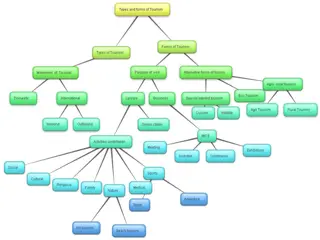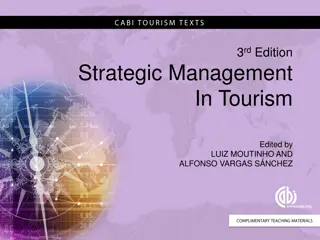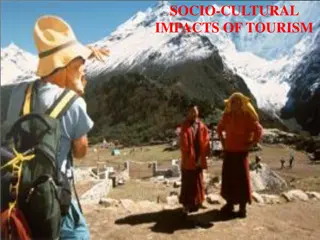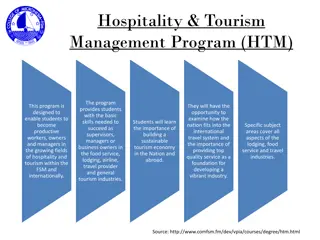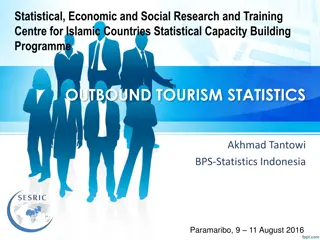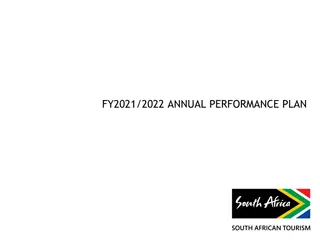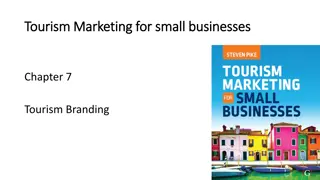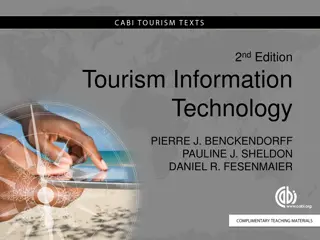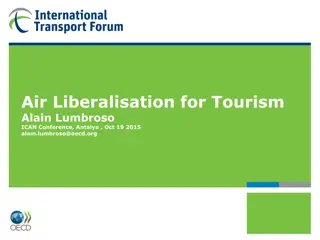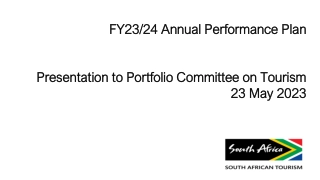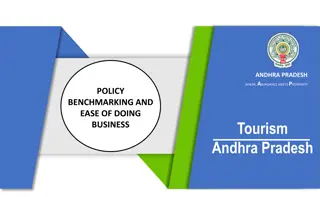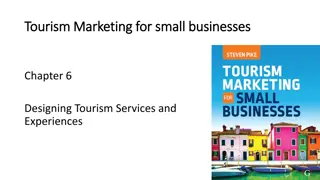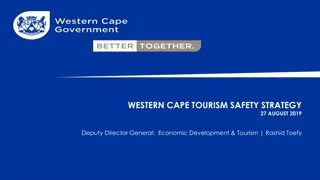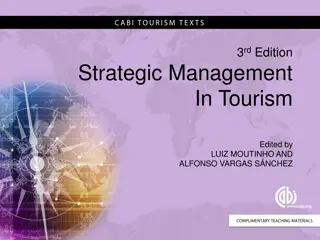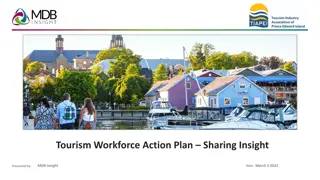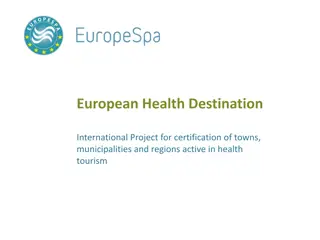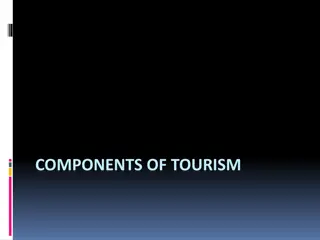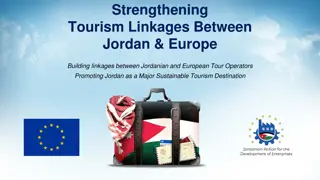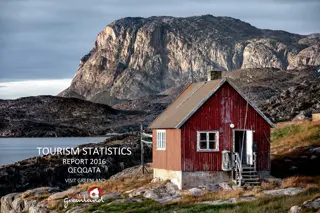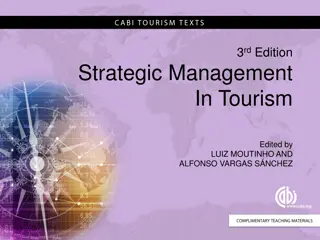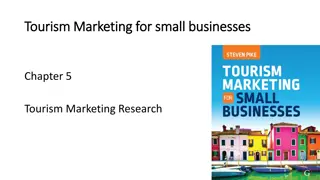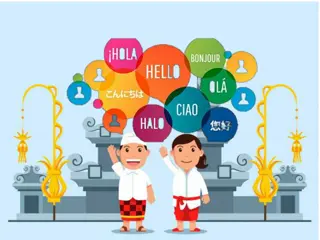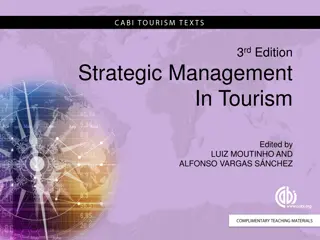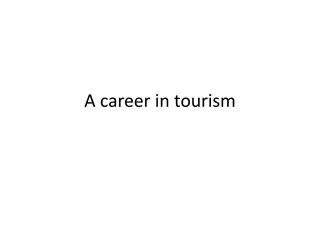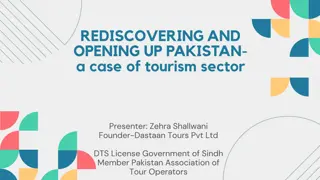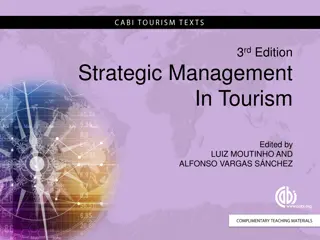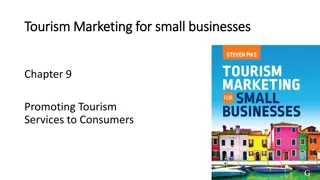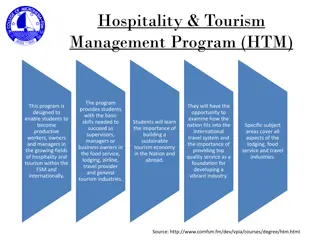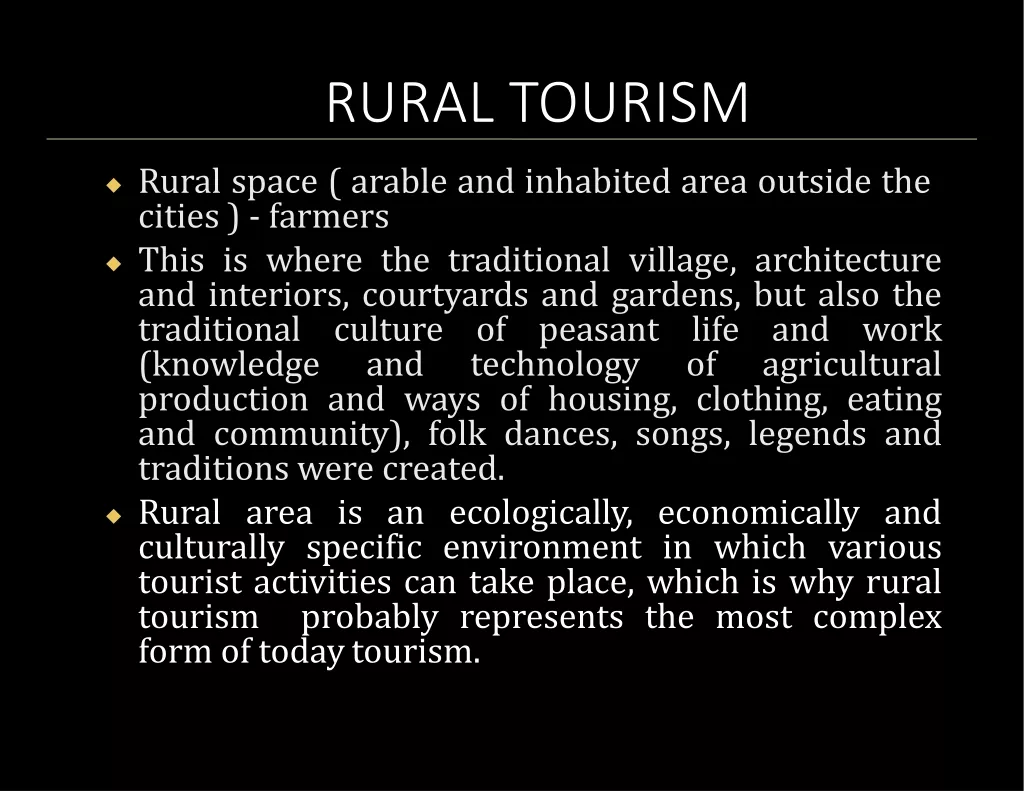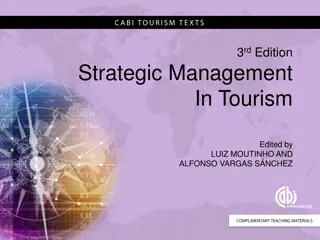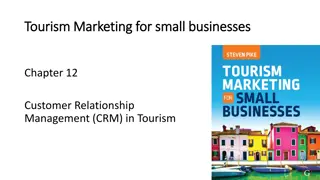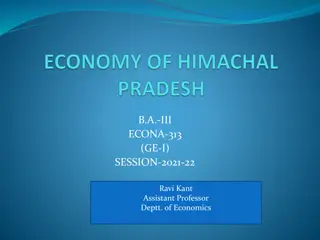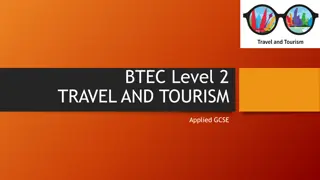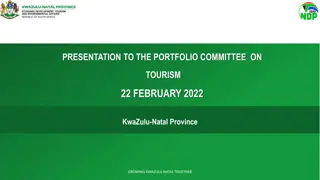Exploring Authenticity in Tourism: Perspectives and Strategies
Explore the meaning, origins, and significance of authenticity in tourism, why tourists seek authenticity, factors influencing authenticity, different approaches to authenticity, and challenges faced by tourism professionals. Discover strategies for achieving and communicating authenticity in tourism management.
Download Presentation

Please find below an Image/Link to download the presentation.
The content on the website is provided AS IS for your information and personal use only. It may not be sold, licensed, or shared on other websites without obtaining consent from the author. Download presentation by click this link. If you encounter any issues during the download, it is possible that the publisher has removed the file from their server.
E N D
Presentation Transcript
3rd Edition Strategic Management In Tourism Edited by LUIZ MOUTINHO AND ALFONSO VARGAS S NCHEZ
CHAPTER 18 AUTHENTICITY IN TOURISM YVETTE REISINGER
LEARNING OBJECTIVES Understand the meaning and origins of authenticity. Understand why tourists search for authenticity. Identify factors determining authenticity in tourism. Understand approaches and concepts of authenticity. Identify main types of authenticity and its meanings in tourism. Understand critique of authenticity and the challenges it presents to tourism professionals. Suggest strategies for achieving and communicating authenticity in tourism. Understand the implications of managing authenticity in tourism.
1 MEANING OF AUTHENTICITY Greek authentikos means real, genuine, original Something of undisputed origin or authorship Reliable, or accurate representation Quality, reputation, trust, sincerity, honesty Local reference, country-of-origin-effect Being oneself, at one with oneself, truly representing one s self
2 ORIGINS OF AUTHENTICITY Transformation Economy:guided personal growth Experience Economy:staged personal experiences Service Economy:delivered customized services Industrial Economy:made standardized goods Agrarian Economy:extracted natural commodities
3 REASONS TOURISTS SEARCH FOR AUTHENTICITY Inauthentic post-modern world: computer automation, imitation, virtual experiences Alienation, a sense of loss in mass culture Importance of meaningful insights into life Desire for clean and pure Gives meanings and increases the value of life Primary source of destination competitiveness
4 FACTORS DETERMINING AUTHENTICITY Tourists beliefs, expectations, preferences, consciousness, and stereotyped images (Bruner, 1991) Locals willingness to display and share traditional practices Businesses can only inspire customers Self-image, cultural values, nostalgia, prior knowledge, the availability of evaluation standards
5 APPROACHES TO AUTHENTICITY Objectivism: there are objective assessment criteria to evaluate authenticity Constructivism: authenticity is socially constructed, depends on subjective judgement Post-modernism: the line between the real and illusion is blurred, world faces hyper-reality Existentialism: focusis on a special state of Being, in which one is true to oneself
6 OBJECT AUTHENTICITY Non-contentious genuineness of an observable thing such as artifact, fossil, dress, or ritual (Reisinger and Steiner, 2006) How people see themselves in relation to the object (Reisinger and Steiner, 2006) Can be objectively verified/measured
7 CONSTRUCTIVE AUTHENTICITY Socially constructed and interpreted quality of tour objects (Bruner, 1991) Constructed by tourists beliefs, images; reflects dreams and desires Symbolic: tourists experience objects as authentic even if they are fake Influenced by mass media Tourists cannot distinguish between authentic and inauthentic
8 STAGED AUTHENTICITY Front stage places with resorts developed for tourists and locals performing services (MacCannell, 1973) Back stage places where locals live and act and tourists want to visit (MacCannell, 1973) Difficult to separate front from back Danger in making a false back region more inauthentic than a false front
9 STAGED AUTHENTICITY (con t) Mass tourism creates demand for staged experiences Authenticity as knowledge (when tourists search for authenticity of originals) Authenticity as feelings (when tourists search for a feeling of having authentic experiences) (MacCannell, 1973)
10 PSEUDO-EVENTS AND AUTHENTICITY Moments staged for the purpose of photo taking (Boorstin, 1961) Dramatic, can be repeated, popular among tourists Allow tourists to change place and time and escape daily existence Allow locals to present themselves to others and redefine their communities
11 NON-PLACES AND AUTHENTICITY Have no cultural or historical ties, no identity Symbols of modern globalization Linked to commercial trade and consumption Serve tourists from any culture Have no impact on tourists, no value, no meaning Tourists experiencing them are left with no memories
12 EXISTENTIAL AUTHENTICITY Existential state of Being activated by tourism (Wang, 1999) Ideal state, or a way of life in which one finds authentic existence and experiences authentic self Creates new values and meanings Has more power than object authenticity to explain tourists experiences
13 EXISTENTIAL AUTHENTICTY (con t) Search for existential Being is destroyed by the desire to conform (Rousseau, 2005) Leaping in and leaping ahead (Hofstede, 1966) Mass tourists leap in , are dependent and inauthentic Authentic tourists leap ahead , are independent, seek self-expressive experiences
14 DIMENSIONS OF EXISTENTIAL AUTHENTICITY Intra-personal (personal) centred on the individual self and concerned with self-making (building self- identity, self-discovery, self-realization) (e.g. adventure, religious tourism, sports) Inter-personal (social) focused on the collective sense of self, authentic interpersonal relations, sharing and communicating experiences (e.g. family, volunteer tourism, sports, backpacking)
15 PERSON-CENTRED OR SELF-AUTHENTICITY Provides the most comprehensive explanation of existential authenticity a) Self-alienation (knowing oneself, being the true self) b) Authentic self-living (acting in accord with one s beliefs, goals) c) Self-influence or acceptance of external influence (not conforming to others) d) Being self-aware (of own strengths and weaknesses) e) Having genuine relationships with others
16 AUTHENTICITY OF LIVING Tourism offers a means for authentic living Living authentically means being non-conformist and willing to face anxiety brought by a new situation (Steiner and Reisinger, 2006) Only everydayness and the familiar warrants authentic living (Brown, 2013)
17 TRAIT AND STATE AUTHENTICITY Trait authenticity: propensity to feel, think, and behave in line with a set of criteria indicative of authenticity; when one s values are upheld State authenticity: the actual feelings and behaviour in a situation; when there is a match between value and beliefs and actions (Endler et al., 1991; Erickson, 1995; Lenton et al., 2013)
18 AUTHENTICITY IN SERVICE ENCOUNTER When a service provider s true self is in line with social obligations or with authority (Deci and Ryan, 1995) Problem: service roles identity is not in accord with the service script a job demands Service providers act upon emotions; feelings prevail over social obligations Service providers can mask their true selves Service employees authenticity may be suppressed and result in the increased or reduced employees sense of authenticity (Yagil and Medler-Liraz, 2013)
19 AUTHENTICITY IN SERVICE ENCOUNTER (con t) Transient authenticity: temporal expressions of true self and personal identity Dispositional authenticity: a personality trait that affects individual experiences and behaviours across roles and situations; depends on the feeling who employees really are and who they feel they are becoming (Yagil and Medler-Liraz, 2013)
20 FINE GENRES OF PERCEIVED AUTHENTICITY Natural: untouched by humans, not artificial, not synthetic Original: original in design, first of its kind, never before seen by humans, not a copy or imitation Exceptional: exceptionally well executed, performed with sincerity, unusual care; unconventional Referential: draws inspiration from human history, rituals and cultures, taps into shared memories and longings, not trivial; experiential, sensual, spiritual Influential: influences other entities, reflects on life and the world, calls human beings to a higher purpose, shows a better way, with meaning; purposeful, aspirational, meaningful, enlightening, humanitarian, visionary (Gilmore and Pine, 2007)
21 CRITIQUE OF AUTHENTICITY IN GENERAL Complex, multi-faceted, confusing Lacks philosophical explanation of its assumptions Multiple definitions and interpretations Culture dependent, not universal Has no common ground as to its existence, meaning, or importance Is obsolete
22 CRITIQUE OF OBJECT AUTHENTICITY Depends upon external assessment Does not determine who is responsible for assessment criteria There is no absolute point of reference what is authentic Static; does not consider that values of the objects change over time
23 CRITIQUE OF CONSTRUCTIVE AUTHENTICITY Negotiable and subjective Depends on the ways of construction and interpretation, and images and expectations of the tour objects Has different meanings depending on time, historical and cultural context, ideology Can be routinized and standardized
24 CRITIQUE OF STAGED AUTHENTICITY Difficult to tell if the experiences of the back stage places are authentic or not Front and back stage places transform over time Pseudo-events insult travellers, are not spontaneous, create dubious experience, have negative effects on the local community (Boorstin, 1961; MacCannell, 1973)
25 CHALLENGES TO TOURISM PROFESSIONALS New conceptualizations of authenticity are required More discussion of what it means in terms of tourists experiences Importance of the multiple meanings attached to tourism products Existential authenticity and the meanings consumed behind tourism products will be important elements of the future tourist experiences
26 STRATEGIES TO ACHIEVE OBJECTIVE AUTHENTICITY Emphasize originality, genuineness, uniqueness Focus on being first and unlike other offerings Focus on not being able to change
27 STRATEGIES TO ACHIEVE CONSTRUCTIVE AUTHENTICITY Create feelings and emotions, recall memories Develop a theme (e.g. sports, landscape) Create impression (e.g. of space, place, time, season, scale, technology Engage senses (taste, smell, sight, sound, touch)
STRATEGIES TO ACHIEVE UNSTAGED AUTHENTICITY 28 In front stages create opportunities for tourists to develop relationships with locals, make friends, learn from locals to gain insights into their culture and society
29 STRATEGIES TO ACHIEVE EXISTENTIAL AUTHENTICITY Focus on authentic state of being: experiencing authentic self, being true to one s self, being attune to one s own experiences Inspire and engage to allow tourists to achieve their goals and aspirations, and change their self positively Deliver offerings that allow tourists to reflect on life, find meaning and purpose, understand the world
30 STRATEGIES TO ACHIEVE NATURAL AUTHENTICITY Focus on being untouched by humans, not synthetic Offer purer and closer to nature products Infuse offerings with the elements of nature (e.g. raw materials, wholesome ingredients, nutrition) Emphasize living natural lifestyle (e.g. beach camps, walking, eating raw) and being green (e.g. green hotels, restaurants, architecture)
31 STRATEGIES TO ACHIEVE ORIGINAL AUTHENTICITY Focus on real thing and original versions of products (e.g. locally made) Emphasize the originality of the design, architecture, being first, different, not a copy or imitation Emphasize a sense of discovery, uniqueness, invention, new ideas, improvement
32 STRATEGIES TO ACHIEVE EXCEPTIONAL AUTHENTICITY Focus on exceptionally well-executed, genuinely performed and caring service Shape offerings around unique tastes and preferences of customers Offer unusual service features, create unpredicted events, deliver surprise, do not sacrifice Be unconventional, emphasize exoticness and foreignness, encourage slowness
33 STRATEGIES TO ACHIEVE REFERENTIAL AUTHENTICITY Refer to previous places, objects, people, events and ideas already perceived as natural, original and exceptional Draw inspiration from history and cultures, tap into shared memories, focus on being not trivial Emphasize experiences and senses
34 STRATEGIES TO ACHIEVE INFLUENTIAL AUTHENTICITY Show the influence of offerings on life and the world Promote higher values, a higher purpose with meaning Inspire and engage to influence the world for the better (e.g. to eliminate hunger and poverty; improve human health; enhance morality and honesty; achieve harmony, justice, freedom, a sense of unity and connection with others; and contribute to human growth and development)
35 COMMUNICATION STRATEGIES Show unique characteristics of the offering Communicate only true image Allow publics and media to experience the offer Show culture and the heritage, the history, the identity and authentic customs of the place Highlight places that are untouched by civilization Emphasize the protected environment, sustainable and conservation efforts Focus on the identity of the inhabitants of the places, their arts, culture, performances Compare with standardized fake offerings
36 IMPLICATIONS OF MANAGING AUTHENTICITY Difficult in the absence of the authenticity in a world Requires experiencing authenticity Businesses do not provide authentic offerings Authenticity is about individual feelings, meaning Different contexts and situations Tendency to conform and lose own self Managing does not allow for being truly authentic Managing is unethical because it shows concern about business gains, not well-being of others
37 IMPLICATIONS OF MANAGING AUTHENTICITY (con t) It is both possible and necessary to manage authenticity for the betterment of individuals, organizations, societies, and our planet with all forms of life that co-exist with us and indeed the whole cosmos (Wilson, 2014,p. 299).
38 AUTHENTICITY AS A REFLECTIVE PROCESS There is a need to reflect on the type of products on offer, how they are produced, their impact on those who produce them and on the world, rather than just sell commodities (Wilson, 2014, p.299) Need to reflect and consider ourselves in different contexts, possibilities within the constraints of the inauthentic world, pay attention to what is important in life, be aware of others, be mindful, accept what one can do, accept the inherent meanings and value of life and the world, and people s capacity to be creative and innovative and have courage (Wilson, 2014)
39 AUTHENTICITY AS A REFLECTIVE PROCESS (con t) Reflection is an important tool to take control of one s own life, letting the conscious I use social and personal values to guide one s actions rather than survival values determined by me , which can be easily controlled by others (Gelter, 2003, p.343) Reflection leads to a more balanced view and understanding of oneself and one s interactions with the world (Gelter, 2003, p.343)
40 CONCLUSION Tourism relies on authenticity Important not to lose authenticity Tourism is about unique authentic qualities and identity, connecting with others and the world, developing feelings, finding a meaning Only authentic tourism can benefit tourists who seek themselves via their experiences



